
| KIT #: | ? |
| PRICE: | $ |
| DECALS: | Three options |
| REVIEWER: | Carmel J. Attard |
| NOTES: | Mild conversion |

| HISTORY |
The Douglas A4 Skyhawk was a
light Navy attack bomber, capable of carrying an atomic weapon. The first A4
was accepted by the Navy on 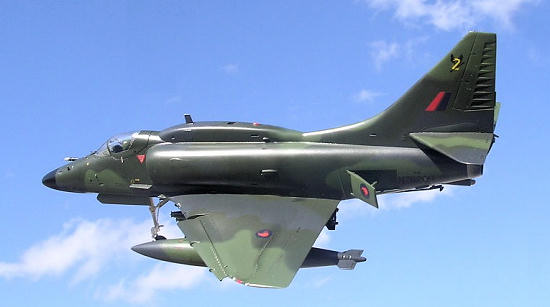 Vietnam War as a bomber and in the 6 day Arab/Israeli war and during the war
of attrition along the
Vietnam War as a bomber and in the 6 day Arab/Israeli war and during the war
of attrition along the
The A4 Skyhawk has been upgraded several times to maintain its effectiveness during its many years of service and many more overseas countries ordered the bomber for their Air Farces. One of these was the Royal New Zealand Air Force which began taking the A4K and TA-4Ks in 1970. Basically this had a drag chute, different radio and a larger vertical fin with squared off tip. The type that was based at Ohakea as recently as March 2006.
More background history of the A4 already documented and can be located among previous kit reviews for different versions of the A4.
| THE KIT |
The 1/32 scale model of the A4 by Hasegawa, my
example being manufactured in Japan and packed in England by AA Hales Ltd,
Hinckley, and Leicester. The kit was purchased in late 1978 from the
Britannia Store at 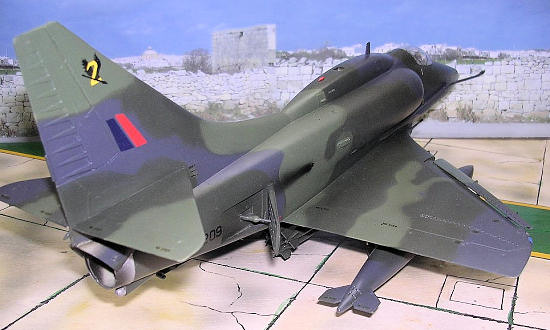 USS
Independence, Forrestal, JFK, Saratoga and America all of which used to
visit our shores during the 60s. The same kit also offered the option to
make a Blue Angels aerobatic team A4. However I kept on postponing the
assembly of the kit for several years until finally I decided to go for a
completely different livery and my fancy fell on a shore based A4K as used
by the New Zealand Air Force. Being a more recent version this required
several changes from the original E and F version.
USS
Independence, Forrestal, JFK, Saratoga and America all of which used to
visit our shores during the 60s. The same kit also offered the option to
make a Blue Angels aerobatic team A4. However I kept on postponing the
assembly of the kit for several years until finally I decided to go for a
completely different livery and my fancy fell on a shore based A4K as used
by the New Zealand Air Force. Being a more recent version this required
several changes from the original E and F version.
The kit is moulded in grey plastic and had lots of detail to the cockpit which is made up out of a number of parts and other fine surface detail which could be found on all other parts of the kit. The undercarriage oleo is convincing replica of the full size units. The wing leading edge slots are all separate items complete with extension rail parts that fit inside the slots. These can be assembled open or closed position. Other details are in the inner faces of the undercarriage doors as well as the Air brakes which are complete with the lightening holes to make them more authentic.
The wing and fuselage components have external
impressed engravings and the upper wings besides the access panel detail to
surface there are the vortex generators which are accurately represented
complete with the correct oblique angle. The under wing stores include two
large fuel tanks that go on the inner wing pylons, two Bull-pup missiles for
the outer pylon and six 500 lb
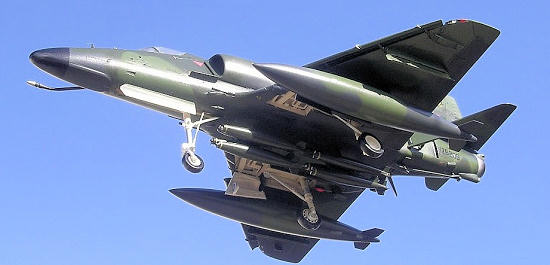 bombs
t fit under the fuselage. All the pylons have convincing surface detail and
the bomb carrier is complete with electrical leads. For the A4F version a
large bulged electronic bay is provided. This is to fit on top of the
fuselage.
bombs
t fit under the fuselage. All the pylons have convincing surface detail and
the bomb carrier is complete with electrical leads. For the A4F version a
large bulged electronic bay is provided. This is to fit on top of the
fuselage.
The decal sheet gives markings for three different aircraft. These are an A-4E (modified to A4F version) of VC-1 of Barbers point Naval Air Service in Hawaii; an Israeli DFAF A4E; and a Blue Angels Skyhawk A4F and for this issue there is also a special drag chute container and gun fairings. The decal sheet for this livery is very comprehensive covering any one of the teamís aircraft complete with selection of numeral registrations.. Apart of the comprehensive instruction sheet there is a colour chart. The A4 size instruction sheets gives full details of the assembly, colour detail to all the kit parts, close up photos of the A4 pylon, U/C bay, nose gear and other areas which are a good source of direct reference.
| CONSTRUCTION |
The 13 stages of construction
as depicted in the instructions were carefully followed in every detail
including painting white interior to wells, air brakes, leading edge slots
inner faces, in preparation to receive the red final finish until a decision
was made to scrap the idea for a USN Skyhawk A4E/F and build an A4K instead.
The New Zealand A4s were upgraded in 1985 onwards, being fitted
with a Head Up Display (HUD),
new radar and navigation system and the hump was later on removed on several
of 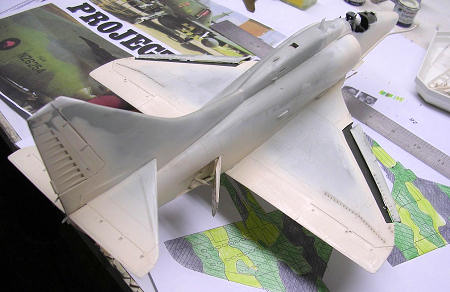 the
A4s. The A4K was operated by No2 and 75 Squadrons RNZAF. These were based at
Ohakea in
the
A4s. The A4K was operated by No2 and 75 Squadrons RNZAF. These were based at
Ohakea in
This is a big scale model and ample of time was allowed for the parts to set dry. Some modifications were made during the process of assembly. This included the modification of the graceful A4 nose consisting of removing the integrally cast on ECM pointed fairing. Root guns had the barrels drilled. The modification itself did not entail an extensive alteration and the majority of items could be fashioned from readily available items that are built into small components fashioned to conform to reference drawings I have acquired from several sources.
The changes that were required include the following:
1 Modifying the tail fin to incorporate the VOR antenna. This involved removing the front curved tail fin and fit in place a reshaped tail fin top made from a laminated plastic pieces to bring right thickness.
2 Detailing the rear small compartment behind the seat bulkhead. This was going to be hardly visible when the canopy is closed.
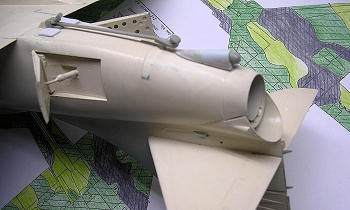 3
Adding a drag chute housing which is located under the rear fuselage. This
was built from pieces of a thick plastic sprue.
3
Adding a drag chute housing which is located under the rear fuselage. This
was built from pieces of a thick plastic sprue.
4 Adding two small ECM sensors to lower tail fin.
5 Altering the rectangular antenna fitted to dorsal electronic pack. This was made from a piece of plastic card shaped accordingly.
6 Re-position the Navigation beacon light from the lower port undercarriage fairing and moved to the starboard u/c fairing.
7 Adding a wing tip ECM antenna to the underside of starboard wing.
| COLORS & MARKINGS |
 The
model depicts an A4K (KAHU) with a serial number NZ6201 of No2 Squadron
based at HMAS Albatross,
The
model depicts an A4K (KAHU) with a serial number NZ6201 of No2 Squadron
based at HMAS Albatross,
| CONCLUSIONS |
This is a nice kit of a popular single seat bomber finished in a most unique camouflage scheme for a Skyhawk which is more normally depicted in Gull grey and white colours. It was not a difficult modification to carry out but more a matter of getting all the details in place having the correct reference material.
| REFERENCES |
SAM Vol 10 No
Air Britain Aeromilitaria Vol 23 issue 127.
If you would like your product reviewed fairly and quickly, please contact the editor or see other details in the Note to Contributors.